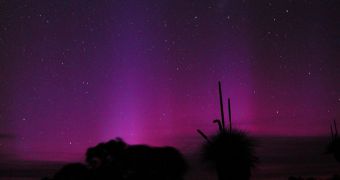While analyzing 2004 satellite images of the poles above the Antarctic, researchers stumbled upon a new type of aurora. Better known are the conventional aurora borealis in the Arctic and aurora australis in the Antarctic, appearing like curtains of brightly colored light in the polar atmosphere.
The light is emitted by electrons from the solar wind being captured and sped by the Earth's magnetic field to power values over 1 kiloelectronvolt. These electrons are headed towards the polar zone where they shock with atmosphere atoms, phenomenon that triggers the light emission. In fact, the aurora phenomenon occurs in a doughnut-shaped area located at both poles and called circumpolar belt, not directly over the poles.
The new research shows that the inner region of the "doughnuts" also has its type of auroras, even if they form from a different reasons than the traditional ones. In determined conditions, the Sun's magnetic field can be linked to the Earth's through a direct magnetic corridor, representing an electrons flow. These electrons are charged with only 100 electronvolt and form "polar rain". As they are not accelerated by the Earth's magnetic field, their low energetic charge is too small to produce light.
Still, there is more polar rain than previously believed, as revealed by the UV-sensitive cameras on a pair of Earth-observing satellites, surveilling the auroras since 2004. In July 2007, a wave of polar rain delivered a much higher energy than it normally does inside the aurora australis.
"The electrons in this wave had energies of up to several KeV, more than enough to generate light. And although not observed from the ground, these particles must have produced a diffuse auroral glow directly over the south magnetic pole." said author Yongliang Zhang of the Johns Hopkins University Applied Physics Laboratory in Maryland, US.
The event was called "polar rain aurora", but the researchers cannot say where the high energies came from. "They must have been emitted from the sun by a disturbance in its activity, such as a sunspot." said Zhang.
The polar rain auroras also have high speeds: one in July 2004 had 200 m (660 ft) per second, or 720 km (450 mi)/h, as much as a commercial airliner. "Polar rain auroras are likely to be common occurrences which nobody on the ground has distinguished from traditional aurora.", said Zhang.
Now researchers want to investigate them from the ground up.

 14 DAY TRIAL //
14 DAY TRIAL //